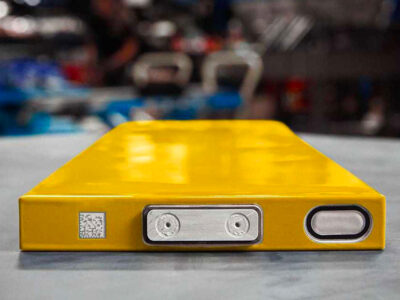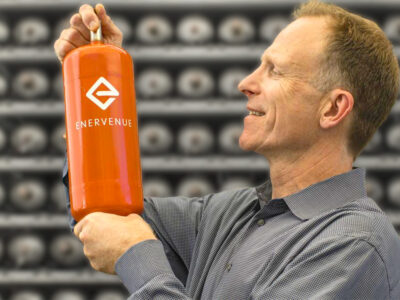With Tesla’s recent purchase of Maxwell Technologies, I thought it was a perfect time to take a closer look at the current state of batteries and what could be next. As well as what supercapacitors are, why so many people are excited by them, and a wonder material that could change … everything.
The present – batteries
A special thanks to Patreon Producer Rob van der Wouw for suggesting a dive into super capacitors, which helped to steer me towards this topic.
So we’re all familiar with lithium ion batteries. They power pretty much everything in our lives at this point from the cellphone in your pocket, to your laptop, smart watch, wireless earphones, remote controls, electric vehicles, and more. But when did they become a thing?
John Goodenough is recognized as the inventor of the lithium-cobalt-oxide cathode in 1980, which was then introduced to the world by Sony in 1991.1 Ever since then lithium ion batteries have become the standard for powering almost all mobile consumer electronics. The same thing that makes them so efficient and versatile is also the thing that can make them dangerous. We’ve all seen the reports of what can happen when a lithium ion battery goes bad.
A lithium ion battery is made up of a positive and negative side. The positive is the cathode, which is most often made up of lithium cobalt oxide; and the negative is the anode, which is made up of carbon (most often graphite). Graphite is going to make a reappearance a little later. The use of graphite helps to produce a flat voltage curve on discharge. And the reason lithium is used is that it’s the lightest metal and also can absorb a lot of electrons.2
Those two sides are submerged in a liquid electrolyte and are separated by a micro perforated separator, which only allows ions to pass through.3 When the battery charges, the ions pass from the cathode to the anode. When the battery discharges, the ions flow in reverse back to the cathode. Every time you use your cellphone and recharge it, those ions are flowing back and forth with each cycle. The reason a battery can explode is that metal can build up during this process on the cathode side [CORRECTION: dendrites grow from the anode] and slowly create stalactite like growths, which are known as dendrites, and those can extend and puncture the separator … and that is when you get exploding batteries.4
So as great as lithium batteries are at giving us all of the amazing mobile technologies that power our lives, it has some dangerous downsides if they aren’t properly engineered or are dropped, punctured or otherwise not properly cared for. Not to mention the downsides of mining for lithium and cobalt, which have impacts on the environment, and in some cases human rights abuses in some mines.
That leads me to Maxwell Technologies innovation that probably lead them to getting purchased by Tesla: dry battery electrodes.5 This shouldn’t be confused with solid state batteries, which is something I’ll cover later. Dry battery electrodes is an innovation in the manufacturing process of the anode and cathode that doesn’t require any liquid solvent in the process. Usually the materials are sprayed on with solvents that then have to be dried or baked off. The solvents and process create off gassing and pollution, so Maxwell’s dry electrode process actually improves the ecological side of battery production.
But the biggest benefits are around energy density, battery life, and cost. Batteries using this method show greater than 300 Wh/kg with a path to over 500 Wh/kg. By comparison, Tesla’s current battery technology, which is considered one of the highest densities available today, is believed to be around 230 Wh/kg.6 That means this technique could add about 23% to Tesla’s current battery density with room to double it. This could lead to vehicles with significantly more range.
The batteries are also showing improved durability with battery life almost doubling. Companies like Tesla typically warranty their batteries for 10 years. Again, this could lead expected battery pack longevity to be much, much longer. And finally, another big reason that Tesla probably purchased Maxwell, the cost reduction. Since this process doesn’t require large drying areas, there’s a 16x production capacity density increase, and 10-20% cost reduction vs. the wet electrode method. Bottom line: it’s going to be cheaper to manufacture better batteries.
The future – batteries
And that brings us to solid state batteries and the race to bring them to market. The basic format of a solid state battery is just like a lithium ion battery. You have a cathode and anode in an electrolyte, but instead of a liquid … it’s a solid. I’m sure you didn’t see that one coming. The exact chemistry and materials used is where there’s a race between various researchers and companies.
Here in Massachusetts is one of those companies, Ionic Materials. They have working prototypes of a solid state battery that they’re trying to bring to market. Without a liquid electrolyte, they’re exceptionally safe and don’t explode when compromised. You can drive a nail through a solid state battery like this, or even cut it in half as it’s being used and it will still continue to work. No fire. No explosion.
They also have higher energy densities than standard lithium ion batteries, which means you can use much smaller batteries to achieve the same power storage on products that we have today. Smaller batteries means fewer materials and lower production costs.
And this is where John Goodenough makes a reappearance with co-author Maria Helena Braga and their “glass battery.”7 At 95 years old John Goodenough is still researching battery chemistries to replace lithium ion batteries with something better, faster, safer, and ecologically sound.
The glass battery doesn’t use cobalt, and lithium could eventually be replaced with easily accessible sodium. That means these batteries could be biodegradable at some point. And as you probably guessed from the nickname, it’s using a glass electrolyte. They can last for more than 23,000 charge and discharge cycles, which is more than a minor improvement over several thousand for a typical lithium ion cell.
There’s still some debate from battery researchers around Goodenough and Braga’s findings, but Goodenough’s credentials as one of the inventors of lithium ion batteries add a lot of credibility to the findings.8
The present – supercapacitors
So with major advancements like that in lithium battery production, we’re done right? Problem solved. Not exactly.
Lithium batteries offer tremendous amounts of energy density, but they’re not great at power density. If you need a huge burst of power, say for an EVs acceleration or a grid scale battery system reacting to sudden demand, lithium ion battery’s aren’t the best option.
This is where super capacitors come in since they have a huge power density. Where batteries are a slower electrochemical reaction that generates electricity, super capacitors are electrostatic … it’s basically static electricity.
A conventional capacitor is made up of two conductive materials separated by a thin insulating material. Apply a current and a positive charge builds up on one side, and a negative charge on the other. No electrolytes needed, which makes them safer and more durable. They’re also able to transfer massive amounts of power almost instantly, which is more appropriate for something like an EV and would allow for charging in seconds. And they have a much greater recharge cycle lifespan than batteries. The reason we don’t use capacitors though is that they don’t have a good energy density. The current technology can only hold about 10 Wh/kg, or about 5% of a typical lithium ion battery. You would need an absolutely massive super capacitor pack to equal what you get in a relatively small lithium ion battery pack.
If only we could combine super capacitor power with lithium ion battery energy density. Imagine what we could do then.
The future – graphene
You knew where I was going with that, right? This is where the “wonder material” makes its introduction. Say hello to graphene.
Graphene is a thin crystalline layer of carbon, at one atom thick. The best way to think of it is that it’s essentially an ultra thin layer of graphite … I told you graphite would make a reappearance, so get your number 2 pencils ready. What makes graphene different is that its atoms are arranged in a honeycomb pattern. A one atom thick honeycomb pattern. This makes graphene not only an amazing two dimensional object, but also one of the strongest materials ever known. This one atom thick material is 100 times stronger than steel.
Research is showing that it could be the next silicon helping to create faster electronics, dramatically more efficient solar panels, and could even become one of the best ways to purify water. It really is earning the “wonder material” nickname. Highly conductive, strong, flexible, and transparent, it has a multitude of possible uses that could revolutionize pretty much everything.
And that leads me to the potential future of a supercapacitor made from graphene that has the qualities of energy dense batteries with the immense power capabilities of capacitors. A recent breakthrough at the v9 has created a 3D printed graphene aerogel scaffold that was loaded with a capacitive material into that scaffolding, and achieved the most energy storage ever in a capacitor.
Imagine phones, laptops, and cars able to charge in seconds to a few minutes, and virtually no degradation from the recharge cycles. Lithium ion batteries may be the reigning champion, but supercapacitors may eventually replace all batteries as we know them.
Final Thoughts
This wasn’t a comprehensive list of all of the different technologies and research being done into energy storage. There’s a lot more out there like flow batteries, fuel cells, and more, but when you focus in on just a couple of areas you can see how quickly things are changing. We’re not going to have cellphones that can charge in seconds in the next few years, as much as we might want them, but you can see what might be a little further down the road. There’s not a straight path from here to there, but there are important incremental updates being made along the way, like Maxwell Technologies dry battery electrodes.
Additional research and articles:
Graphene Supercapacitors: Introduction
An Arkansas Teen Helped Turn Tea Leaves and Molasses Into a Supercapacitor
How Supercapacitors Could Make Batteries a Thing of the Past
Energy storage leap could slash electric car charging times
A fluke breakthrough could be the missing link for an electric car age
Next Stop: Ultracapacitor Buses
How do Lithium Batteries Work?
Anticipating supercapacitors for laptops, tablets and smartphones
Tesla Plans to Acquire Maxwell Technologies in Deal Valued at $218 Million
The Ultracapacitors, Electrodes, & Battery Manufacturing Tech Tesla Gets With Maxwell Technologies
Powering the Future: Solid State Batteries
Citations:
1 http://en.wikipedia.org/wiki/Lithium-ion_battery
2 How do Lithium Batteries Work?
3 How Lithium-ion Batteries Work
4 Fire-starting battery dendrites go with the flow
Maxwell Technologies 21st Annual Needham Growth Conference
6 New Tesla Model 3 Battery Details
7 http://www.axios.com/battery-pioneer-1528047409-d0515380-1881-4e96-891f-3763eaa84666.html
8 http://www.economist.com/technology-quarterly/2018/11/29/john-goodenough

















Comments